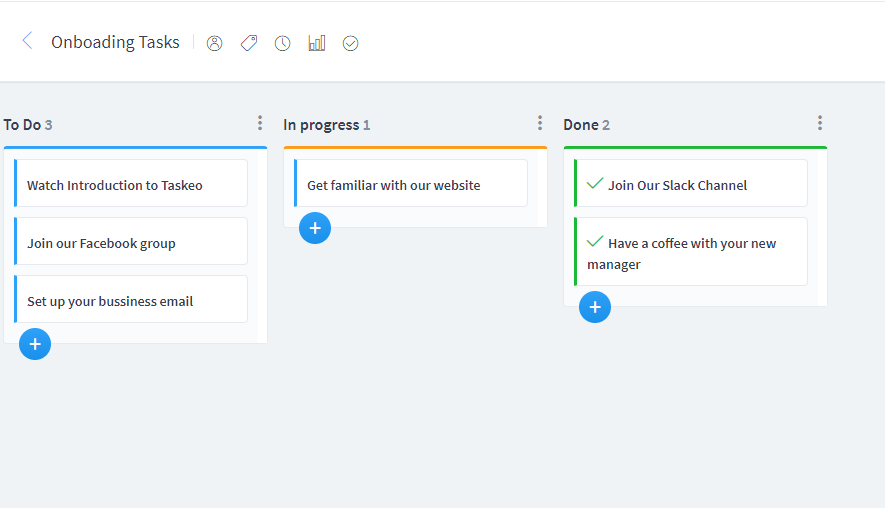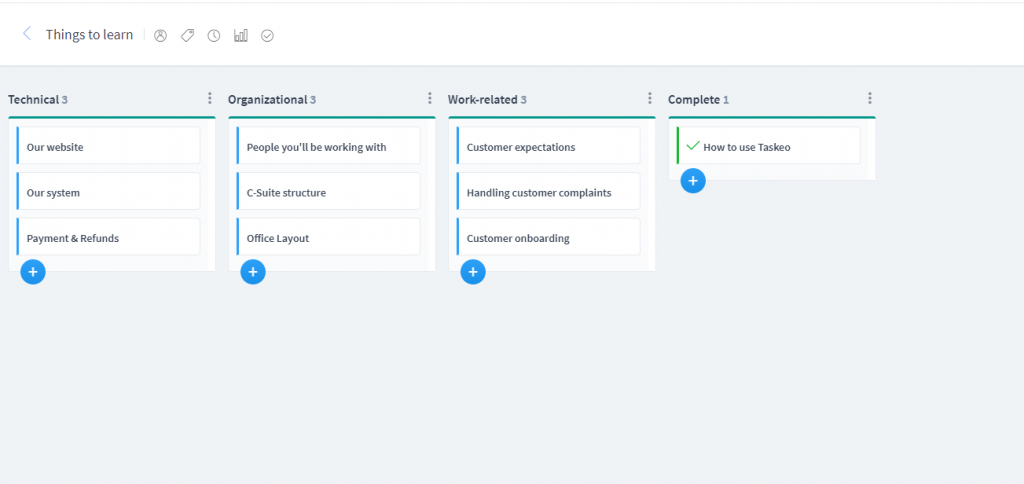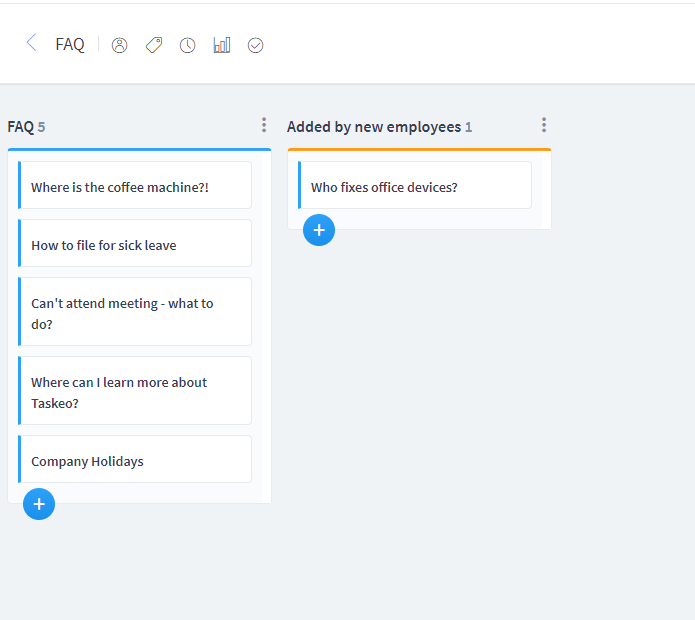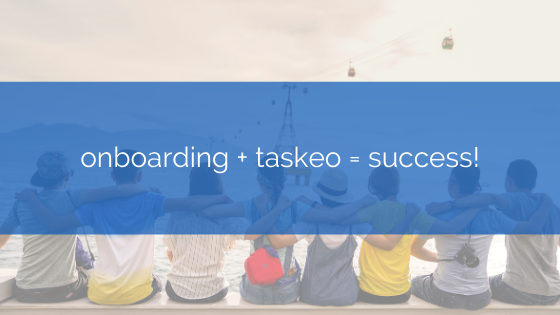A new person joining your business can prove to be quite a stressful event. And not only for the new employee themselves but also for you and your team. The way you go about onboarding new employees will define the nature of your first weeks together.
In his article for Harvard Business Review, Ron Carucci argues that the correct onboarding of new hires can increase employee retention.
“If you want to retain the talent you spend good money to acquire, make sure a new hire’s first year is positive and productive. Organizations with a standardized onboarding process experience 62% greater new hire productivity, along with 50% greater new hire retention”, he says.
However, the issue of how to onboard new employees becomes real headache when you – and your team – have no prior experience in completing such a task. Especially in small organizations, such as local businesses or startups, staff onboarding is often overlooked or carried out poorly.
Maybe you don’t know much about employee onboarding and you don’t have a specialized HR department to help you out. This is something that you can (and should) fix as soon as possible to prepare your business for growth and the increasing number of employees.
We’re here today to help you out with this problem. From the following post, you will learn more about these matters related to how to onboard new employees:
- the common problems experienced by new employees
- how to create an effective onboarding program
- how to use Taskeo to help you with onboarding new employees in your business
Ready to dive in?
Common problems experienced by new hires
No matter the experience a new person brings into your company, they’ll still feel new to the place. Their knowledge and expertise may be universal but the way you run your business is not. That’s exactly why people still feel unsure whenever they join a new team. And that’s also why everyone – no exceptions – needs onboarding.
There are as many potential issues as there are new employees in every business. However, some of them are common enough for us to use them as examples of standard new employee worries.
Their knowledge and expertise may be universal but the way you run your business is not.
I don’t understand the company processes
“I’m not new to my job but the processes here are different than I’m used to. I’m afraid that I’ll complete my assignments but not the way it’s expected. I can’t find anyone to tell me how we handle my scope of duties.”
Other employees don’t acknowledge I’m new
“They just assume I know how to handle everything, know the internal processes and recognize everyone by name.”
I’ve been thrown into deep water from day one
“They gave me a pile of assignments to complete as soon as I showed up in the office.”
My scope of duties isn’t clear to everybody
“Other employees ask me to do things that I never agreed to do or discussed during the job interview. Someone is misinformed and I’m unsure whether it’s me or them.”
I don’t know where to turn to help
“I hardly ever see the person that interviewed me, the boss is out of reach and other employees are too busy to help me out. I’m clueless who to ask for support.”
They overloaded me with information
“There was some onboarding, but it lasted a day and confused me more than not. I’ve been told too much and explained too much. I’ve already forgotten most of what was said.”
I wasn’t given time to memorize everything
“I think they expect I’ll remember everything from the get-go. I feel stupid when I keep asking about the things I’ve already been explained.”
Each new employee experienced at least some of these issues. And while they could be counted as common, they can easily spiral out of control. Their results might range from frustration and stress to outcomes as extreme as the new hire giving up on their job weeks or months later.
So how do we solve this issue?
Read more: Successful Teams Say NO to These Things
Solution: Creating Onboarding Program in Taskeo
Taskeo is a versatile tool that can effectively assist you in onboarding new employees.
You may instantly ask: how to onboard new employees… with a project management platform? Is this even possible?
Yes, it indeed is. That’s where Taskeo’s versatility plays a major role.
Most importantly, you’ve got to have an employee onboarding program in the first place. No, one afternoon of training your new hires the basic stuff won’t do. Onboarding is a process that can take weeks or even months.
Gallup found out that “bank tellers often take 12 to 15 months to fully “ramp up” in their new role, and personal bankers take 15 to 18 months. It can take much longer for complex leadership and management roles”.
That’s why onboarding new employees in the digital space or even automating the process can make a huge difference for you and your team.
With Taskeo, you can think of onboarding as a project. That subtle mindset shift will allow you to discover that indeed, even in this case you can fully benefit from all project management features at your disposal.
The next part of this article will show you how to onboard your employees with Taskeo and its project management features.
Preparing the employee onboarding plan
Before you actually transfer your new employee onboarding program to Taskeo, make sure you’ve prepared it ahead. There are several good practices to follow if you want to minimize the number of issues arising during the first weeks of work with the new person.
Everyone onboard
The smaller your business, the more likely it is that everyone in it will be interacting with the new employee. That is why everyone should be included in the onboarding program, even if they’re not directly tutoring the new hire.
Inform your entire team that there will be another person joining them soon. Current team members, even if not directly responsible for the onboarding, should stay open-minded and ready to offer assistance.
Write it all down
Make sure you’ve got a written, easily accessible onboarding curriculum. Be thorough with it and list every single thing that you think the new employee has to master.
From the internal processes to the best practices of contacting your customers, everything has to become a part of your new employee onboarding program.
Estimate the duration of the training period
While it may take as much as a year for the new person to feel comfortable in their new role, they will most likely be able to grasp the basics of their responsibilities much earlier than that.
Make an estimate how long, according to you, it would take to pass all the needed knowledge and best practices to the new person.
Distribute the knowledge on a timeline
When thinking of onboarding new employees, imagine the whole process as a course.
No course gives you all the knowledge at once. It’s divided into smaller, acceptable bits. Lesson by lesson, students learn more and have time to practice what they learnt.
Your new employee onboarding program has to work the same way. If you first made a list of things you want to teach them and estimated how long would it take, then your next task is to evenly distribute each “lesson” on the onboarding timeline.
How to onboard new employees with Taskeo: Nuts and Bolts to Begin With
Prepare the space
To proceed with onboarding new employees in Taskeo, need to have an account for your company and team. It’s free to create and you can sign up here.
Once you do that, you can begin creating your onboarding space.
While your new employees will share some workspaces and projects with the rest of your team, make sure you prepare a separate, onboarding space. You can use a dedicated Workspace for this purpose. Thanks to this, you will have plenty of room to create employee onboarding projects.

Assign the right people
In the next step, assign all the new employees to the onboarding workspace. Make sure to add all other people involved in the onboarding process as well.
Remember to do the same for each of the onboarding projects you’ve created.

Prepare projects
New employee onboarding is a complex project that may consist of active tasks as much as of “passive” materials. To reflect this, you should create a variety of different projects that will serve different purposes.
Here are some of the project examples that you can use in your own onboarding process.
Active tasks. You can use this project collectively for several new employees or create one for each of them. It’s up to you and to the number of people you’re onboarding. This projects will contain tasks related to the onboarding process that will help your employees settle in. Here, you can assign them to-dos such as “Join our Slack channel” or “Deliver your tax info to HR person”. This way, you will ensure that everything that’s important has been assigned to your people and they won’t forget about it. Using such an active task project is also a great way to help your new employees get used to Taskeo and its basic task management features.

Things to learn. This project can be based on your onboarding curriculum. Everything that you want your new employee to learn can and should be put here. Once the training has been completed, you can check the task off and use it as a knowledge base for future reference. It will simplify the learning process, allowing you to stay on top of what’s been covered, what’s there to covered and what needs repetition.

Basic company information. This project could include the basic company information, such as team roles and structure, manifesto, history or anything else you deem important enough to share with your new employee.
Training calls or meetings. You can use a booking project to manage meetings with your new employee. Within each meeting, you can list things they should prepare or make an outline of things that will be discussed.

FAQ. This project can become ask & answer space for your employees. Some questions can be prepared ahead but it might be a good idea to let employees ask their own questions for senior members to answer.

Knowledge base. Opposite to Basic Company Information project, this one will teach your new employees about their role. Things such as “how to talk to our customers” or “how to handle complaints” can be placed here along with useful links, videos or online courses you make accessible for your team.
Modifying these projects is always an option. After all, you know best what are the needs of your business and how to onboard new employees the way you’ll all benefit from it.
Read more: Making The Most Out of Your Kanban
Solving the common issues of new employees
Let’s go back for a moment.
At the beginning of this post, we’ve described several common issues that a new employee can experience once they join your team. In this section, we’ll show you how to solve them and thus make the new employee onboarding smoother and easier for everybody.
Explain the company processes
How you run your business and how your employees handle their day-to-day duties should be a separate part of your onboarding “course”. As we said already, each company is different. Teams form different habits that help them achieve their goals. These things, in opposition to industry knowledge, are not universal.
It is important that you run your new employee through this. Internal processes can be a part of your learning project, they can also be described in your FAQ or Knowledge Base.
These matters, even if simple to you, can be quite complex to a new person. It will make a huge difference if you both explain it verbally and keep a written version of your instructions for the new hires to review anytime they need it.
Get others involved
Make sure your new employee isn’t under too much pressure coming at them from everywhere. Other team members should acknowledge them being new to certain things and help them out instead of overwhelming them with requests.
It’s a good idea to involve other people in the onboarding workspace so they can add materials, answer questions and help in the training process.
Don’t throw them in the deep water
It’s likely that you need your new employee to start working at their full capacity as soon as possible. Maybe other team members are overloaded and stressed out. It’s understandable that you don’t want to prolong this situation for several more weeks.
However, it’s important that you allow your new hires to warm up. Let them get familiar with the software you use, with their team, with processes. Give them time to test their expertise and check how comfortable they feel task by task. Monitor how they’re handling their load and steadily add to it.
Make their role clear
You may have discussed the new employee’s responsibilities with them, but most likely the rest of your team wasn’t part of that conversation. Make the new employee’s scope of duties clear to them as to the rest of the employees who are already working for you.
Create a go-to source of help
Your new employee should have someone to look for when they’re in need of assistance. Whether it’s going to be you or a senior team member, make sure that person’s role is clear and they’re available, eager to help and capable of doing so.
Sources such as FAQ or Knowledgebase projects will also prove priceless.
Distribute the information steadily
Overload of information will only confuse your new employee. It’s understandable you want them to be ready for their role as soon as possible. However, teaching them everything at once and hoping they’ll remember it all won’t get you anywhere.
With the use of the learning project, you can set milestones and teach your new employee everything they need to learn at a steady, reasonable tempo.
Don’t forget to check in with them every now and then. Use your dedicated calls to refresh on things they’ve been told so far and to ask them if they don’t need additional help or explanation.
Give them time
Don’t expect them to master your new role within the first week. Onboarding is a lengthy process and it only starts with teaching your new employee the basic ways to handle company processes.
Encourage your new hires to observe the company and identify what’s not clear to them. They can successfully use one of the projects you’ve set up for the onboarding process or use Taskeo’s private projects to take notes and create their own learning task.
How to tell if your onboarding process was successful
There’s no point in spending weeks onboarding new employees if the whole program doesn’t yield satisfactory results.
Onboarding is a lengthy process and it only starts with teaching your new employee the basic ways to handle company processes.
One of the main problems companies face when it comes to onboarding is that they don’t know whether their way of onboarding new employees is successful.
Luckily, there are several ways to tell.
- Your new employee visibly feels better at their workplace day after day – and they’ll confirm feeling so when you ask them.
- They handle their task more effectively and efficiently. They work more on their own as time passes and make fewer mistakes.
- They ask fewer questions and raise fewer concerns.
- You feel more and more comfortable about working with each other. There’s more trust between you and the new employee, as well as between them and your senior team members.
- Your current team members don’t bring up any issues related to the new employee.
- You’re satisfied with the results of the new employee’s work…
- …and they’re satisfied with their reception and the new workplace.
- Your employee retention is higher while the employee turnover steadily decreases.
When it comes to onboarding new employees, there’s no one good way to do it
Companies and people working in them are unique. Some people will need a longer onboarding process and others will adapt faster.
The problem of how to onboard new employees isn’t solved the same way in each company out there.
Finding the right way to onboard your employees for specific roles within your business may take a bit of a trial and error. With your team expanding more and more, you’ll gain additional experience that will guide you through the whole process time and time again.
So, when is your new employee arriving? 🙂






